Zoom
Trash

SyncMD
Improving EHRs. The prevalence of electronic health records reveals the ubiquity of technology in healthcare.

From its inception in the late 20th century to today, EHRs remain a staple part of any hospital. However, with the development of new and polished medical technology such as robotic surgery and Telehealth, the age of EHRs are beginning to show. While the benefits of patient record management software are undeniable, EHRs are not immune to criticism, or improvement. What's New for Medical Technology? Predictions for Healthcare Innovation in 2020.
2020 is upon us, a new decade of countless possibilities.
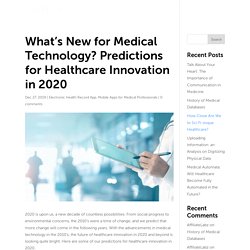
From social progress to environmental concerns, the 2010’s were a time of change, and we predict that more change will come in the following years. The Ability of Compatibility. Compatibility isn’t just important in a loving relationship.

Even for electronic health records (EHR), medical apps are in need of good compatibility. Why? It helps patients communicate and share data with other EHR software and medical systems. EHR’s importance on the healthcare industry can vary due to its usefulness in many instances. From times of emergencies to moments where someone loses their medical records printed on paper; EHR is indeed a benefit for the patient. But why is its compatibility important? Imagine yourself in the emergency room. You panic. You didn’t know your acquaintance’s medical history but you know they have an app that has their complete medical history. The doctor thanked you. But they quickly went pale as they realize that the app wasn’t compatible with their EHR system. Mistakes in the Machine: Critiques of the Electronic Health Record. Medical technology has advanced by leaps and bounds throughout the course of human history.

Ever since the start of the digital age, with the flow of information allowing for more cohesive and united developmental research, healthcare technology, from mechanical surgeons to mobile medical apps, is gearing to change the medical landscape in the coming decades. However, while technology continues to play an important role in the practice of medicine, performing work that greatly assists in the diagnosis of patients, defects and clerical issues can plague these devices and programs, potentially jeopardizing the lives of patients. How to Slowly Ease Burdens as a Physician – Healthcare Technology Updates. Doctors are not just dealing with patients all day long.
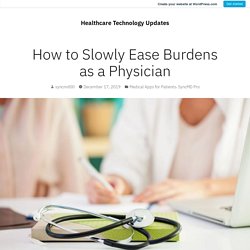
People usually expect doctors to be busy meeting people all day long, when in fact, they are dealt with various other things that people outside the industry of medical care cannot comprehend. According to research, there are 10 areas that cause a burden in doctors. One of which is paperwork, which is quite unlikely for non-doctors.
Doctors spend approximately 50% of their time doing paperwork in the clinic, whereas they spend only a percentage of 27% seeing patients. An Age of Portability. The historic monuments of the Classical Era—The Pyramids of Giza, the Acropolis of Athens, the Angkor Wat of Cambodia—are known for their vast size and magnitude, the persistent remnants of antiquity towering over people in the modern-day.
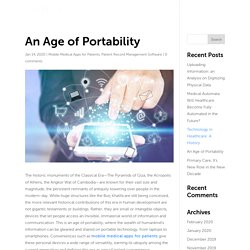
While huge structures like the Burj Khalifa are still being conceived, the more relevant historical contributions of this era in human development are not gigantic testaments or buildings. Rather, they are small or intangible objects, devices that let people access an invisible, immaterial world of information and communication. This is an age of portability, where the wealth of humankind’s information can be gleaned and shared on portable technology, from laptops to smartphones. Conveniences such as mobile medical apps for patients give these personal devices a wide range of versatility, earning its ubiquity among the current generation and defining this era as one of instant convenience. Technology in Healthcare: A History. Outdated Communications Technology in Medicine.
The Age of Technology has revolutionized the way people communicate with each other.
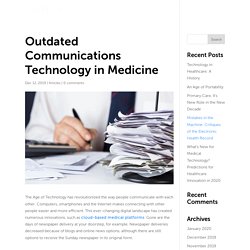
Computers, smartphones and the Internet makes connecting with other people easier and more efficient. This ever-changing digital landscape has created numerous innovations, such as cloud-based medical platforms. Gone are the days of newspaper delivery at your doorstep, for example. Newspaper deliveries decreased because of blogs and online news options, although there are still options to receive the Sunday newspaper in its original form. From One Family Physician to Another. I used to make home visits, but the time/cost pressure on me in private practice forced me and my group to give that up.

We also gave up having in office mammography, nursing home care, hospital care, and hospice care. It doesn’t pay enough to make it worth our while. Now the MA plans pay primary care docs to make home visits to upcode the charts, but NOT the actual physician of that patient, because these home visits have NO clinical use. They are only a way of gaming the Medicare reimbursement system that increases payments for higher risk adjustment created by adding more codes. Just a coding racket. The Good the Bad and the Brand-new: How Technology Changed Patient Treatment.
Medical technology has come a long way, from the dissection-based anatomy lessons in the Middle Ages to the advanced, 3D-enabled surgery simulators of today.
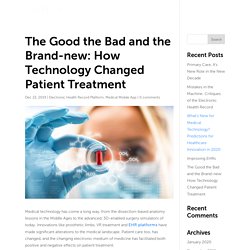
Innovations like prosthetic limbs, VR treatment and EHR platforms have made significant alterations to the medical landscape. Patient care too, has changed, and the changing electronic medium of medicine has facilitated both positive and negative effects on patient treatment. The Good. Why Doctors Should Have A Medical Reference App. By Sync MD Electronic Health Record App Nowadays, there is a mobile app for nearly everything under the sun -- be it a game about candies, a guitar tuner app, a cycling and running GPS tracker, or food delivery services.

The field of medicine is no exception to the rule. There are plenty of apps available that cater to different specialties, from pharmacology to cardiology. Diabetes and heart health management apps are very common, for instance. There are also apps that compile information on drug recommendations and dosages. It's true that many mobile medical apps seem to be more patient-oriented. What To Expect With Medical History Applications. Technology and medicine are always in synchronization. As the technology steps forward, the medical trends also change. With the rise of computerized hospitals and clinics, electronic health record (EHR) platforms also entered the picture.
EHR platforms are the electronic or digital versions of a patient’s medical history. What To Expect With Medical History Applications. Record-keeping in the Digital Age - Sync MD - Medium. Not everyone has the talent for organization. Let’s say you’re a medical secretary and working in a private clinic. This requires you to multitask. Day after day, you receive patients, help them fill up forms, retrieve and update their records, encode medical reports and provide that link between doctor and patient. In many ways, both doctors and patients rely on you to keep all their documents intact, especially medical records.
While you’re excellent at your job, people have off days. Mobile applications have been developed to address record management. Here are other advantages of using an electronic health record software: Time managementAccess to EHRs (Electronic Health Record) and EMRs (Electronic Medical Record)Access to images and scansElectronic prescriptionsMonitoring of patient health and even location Seeing a doctor is stressful enough. Sync.MD Pro. An App a Day Article. There seems to be a mobile application or what’s simply called an “app” for everything these days. Smartphone Apps For Women’s Health. For women, health should always be the main priority. But due to busy schedules, women tend to disregard their health status, especially their reproductive health.
Due to this reason, most women-related diseases such as breast, cervical, and ovarian cancer are discovered late. This App Will Help You Manage Your Medical Records! – Healthcare Technology Updates. Having your medical records handy is something that every person would want, but who would like to carry a bulky folder or envelope full of medical documents with them, right? Well, what if I tell you that mobile application developers have created a patient record management software for you to keep your medical files handy? What is a Patient Record Management App?
The Guide to Finding the Best Mobile Tools for Your Medical Practice. With the dramatic need for a more detailed, and secure health record storage, the introduction of cloud-based medical records has revolutionized the healthcare industry. This technological advancement was developed to make higher quality healthcare program its foremost priority. How do you know you’re using the best mobile medical tool for your patients?
It’s Patient-centric Whatever platform you choose, the effectiveness of electronic health record system is primarily measured by how well it benefits the patients. IT Barriers to Overcome in Healthcare. Author: Dr. Personal Health Records & Control.